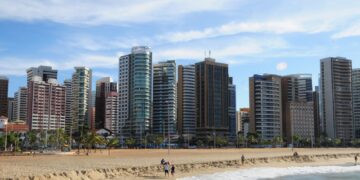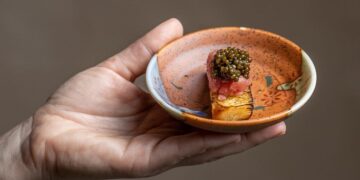
Between the mysticism of the pilgrims’ beliefs and the modernity of the metropolis Crajubar, between the mild climate and the green landscape of the crato and the fossils of the Geopark, Cariri shows itself as one of the most attractive regions for tourists of the most diverse types. In our new cover story, the VemTambém team also unveiled the mysteries and beauties of one of the richest and most diverse locations in the Northeast! You don’t need to take a breath to get to know the Cariri Region, in Ceará. The destination alone offers what is necessary for you to fall in love with every corner, for the friendliness of the Cariri people and for the excitement that everyone has when welcoming you. We decided not to frame our trip as Religious Tourism, Cultural Tourism or Historic Tourism. It is all of that, but it runs and goes far beyond. From the blessings of the famous and famous ‘Padim Pade Ciço’ to the curiosities about the formation of our planet, Cariri is undoubtedly one of the richest and most important spaces that make the Northeast so charming and Brazil so diverse and welcoming.
Once, in 1952, the King of Baião, Luiz Gonzaga – a native of Exu, in Cariri Pernambucano – said that he would only leave that place on the last stick of macaw. In this edition we come to understand and understand this song more, and the charm that makes people from Rio de Janeiro so passionate about their land. There are nine municipalities that contemplate the region, among them the cities Crato, Juazeiro do Norte and Barbalha – which form the Crajubar triangle -, Jardim, Missão Velha, Caririaçu, Farias Brito, Nova Olinda and Santana do Cariri. The cities, located in the south of Ceará, maintain their close ties and without disparities, forming an entire complex that avoids socioeconomic inequalities between capital and countryside. With an approximate distance of 600 kilometers from Fortaleza, the destination is contemplated by the vegetation and climate of the semi-arid region, showing all the characteristics of the Ceará backlands.
The VemTambém team also visited several tourist, historical and prehistoric sites in the cities of Juazeiro do Norte, Crato, Barbalha, Santana do Cariri and Nova Olinda for the production of this article. From our journey, we realized that Cariri offers tours for different types of travelers. It is difficult to choose just one. The paths of faith, cultural manifestations, history and prehistory, in addition to the pulsating modernization of the second largest region in the state of Ceará – were axes that guided our editorial in an attempt to show the essential to our readers. Ready to emerge in this hot world (let there be heat on this tour!) Full of culture, natural beauty and lots of history? Prepare your heart for this special report that marks the 14th edition of our magazine, illustrated with incredible colors, symbols and landscapes! “I only leave my Cariri on the last stick of macaw” Luiz Gonzaga, the king of baião In the photo beside, the grand statue of Nossa Senhora de Fátima do Crato. On this page, respectively: an aerial view of Colina do Horto in Juazeiro do Norte, the parish church of Santo Antônio in Barbalha and the famous Cristo Rei, one of the symbols of the city of Crato Thinking about Cariri, researching Cariri and experiencing Cariri is also meet one of the most important figures who lived there: Father Cícero Romão Batista. The 27 meter high statue that crowns Colina do Horto in Juazeiro – one of the most visited tourist spots in the whole of the northeast – eternalized the memory of the “popular saint”, always looking out over Juazeiro do Norte, protecting and watching the pilgrims full of who visit the ‘juá lands’ to pay promises or ask for graces. It was in this space that we had a real lesson on the faith of Father Cícero with the guide and advisor of the Casarão do Padre Cícero, Edna Barbosa. An employee hired by the City of Juazeiro do Norte, she tells us at the beginning that when she passed the municipal competition she chose to be there, to work there. “It is a way of renewing the faith daily, being in contact with so many faithful and telling the life of Father Cícero”, he reveals, his eyes shining with joy and gratitude for the function.
The over 30 ° C relieved by the constant winds of Colina do Horto seem to encourage her to tell stories about the vows and the tests of faith that move thousands of people every year to Cariri. The Casarão, today the Living Museum of Padre Cícero, as Edna tells us, was the place where Padre spent his weekends. There, he set up a small straw chapel to perform his prayers. The landowner, upon realizing this action, donated it to the priest and, subsequently, the building that remains with the original structure and floor, but full of testimonies of miracles, was set up. The first room functions as a small chapel – never empty – space for requests and thanks. The rest of the house is illustrated with wax statues that show parts of the life of the house, like a scene created in full size – surrounded by a glass protector – where Father Cícero has a meal with politicians of the time, a blessing and a Romeiro, all listening attentively to the orientations of the popular leader. The other rooms, with the exception of the last, are dedicated to the miracles and vows that have been requested and conceived. The pilgrims usually thank the graces achieved by taking small representations of the body – or even in real sizes – such as feet, legs, breasts, hands, arms (the so-called ex-votos) to the mansion; photographs; The 27 meter high statue that crowns the Horto Hill in Juazeiro has eternalized the memory of the “popular saint”, always looking out over Juazeiro do Norte KNOWING THE PATH OF CÍCERO AND THE GIANT RELIGIOUS STATUES OF JUAZEIRO AND CRATO
At the top of the page, ex-vows in the form of hearts made by penitents who made promises regarding this part of the body. Beside it, one of Father Cícero Romão’s Baptist cassocks kept in the Casarão do Padre Cícero. Still on this page, above, the always inviting smile of Dona Edna and the side, the peace in the eyes of Dona Luzia, who arrived in Juazeiro as a girl to live next to ‘Padim Ciço’. Known as one of the most beloved and controversial priests in Brazil, the popular Padim Ciço, besides being a priest, did everything: he was a politician, teacher, counselor, friend, student and many other trades developed by citizens in a municipality. But it was because of his famous miracles that so many believers became devotees and pilgrims to the priest. One of the most famous that is precisely told by the Cariri people is the phenomenon of the sacred host that bled into the mouth of Blessed Maria de Araújo. The action is a direct relationship to the body and blood of Christ, which took place physically there in the city of Juazeiro do Norte. After that, the city became a place of pilgrimage, as a place to praise, ask and thank for miracles mediated by the priest.
Two years after the incident, he was accused of mystification and heresy, had to travel to Rome and reconcile his trajectory with the Catholic Church, but was forbidden to celebrate masses – although he did not fulfill his ‘sentence’ and went much further, when in 1911 he became the mayor of Juazeiro for 15 years. Forgiveness and rehabilitation as the profession of a Brazilian priest only arrived in 2015, ordered by then Cardinal Benedict XVI, who reordered him within the institution. But this was a mere formality, since the faith for his person makes Cariri what it is: space for pilgrimages, faith and the birthplace of a lot of culture, immortalized by his statue at Colina do Horto, which celebrated its 50th anniversary in 2019. CD’s (we found an album by the back country duo Maiara and Maraísa and another by the singer Marília Mendonça) and order boxes. It was in the middle of the conversation with Edna that we learned about the story of Mrs. Luiza Maria dos Santos, now 96 years old.
Coming to Campina Grande (Paraíba) at the age of 12 on a journey on foot, she spent her life caring for the priests who landed in Horto and came to embrace Father Cícero. Embarrassed, she smiles with her eyes and reveals a vanity with a lot of sweetness and purity. Currently she does not have a good recent memory, but the stories of the past and her life dedicated to faith, she never forgets. Besides, who would forget? All very alive, as the name of the place suggests and as revealed by Edna. “My great-grandmother took care of Father Cícero’s mother while he spent a year in Rome … And this story was passed on to my grandmother, my mother and today to me. My connection is strong”. And that strong connection forms a bridge to the city center, where he lived during the week. This time it was the guide Adriano Pereira who narrated the visit of the open house to the public and which also functions as a shelter for the so-called ‘godchildren’.
Right in one of the first rooms, one of the most important furniture there: the bed, where the religious spent the last hours of his life. Again, same scenario: the place is occupied all the time with people placing orders, depositing personal items and crying out for blessings. A panorama of faith capable of moving even the most unbelievers. As in the Vivo Museum, in this house – entitled Museu do Padre Cícero – the objects of followers mix with personal objects of the religious. The visitor will find there original clothes and hats kept in bellows and closed cabinets; as well as a part of the private library with books in different languages. Like Dona Edna, Adriano is also another devotee of the patron; both stories are in a space that mixes emotion and desire for the good and peace of all in order to live serenely and with less war, under the watchful eye of the authority that watches over the city, welcomed by the cloak of Our Lady, whose statue adorns the neighboring municipality, Crato.
Embracing Juazeiro do Norte and multiplying affection, joy and hospitality, the Cratenses have a statue of the saint on top of the Nossa Senhora de Fátima garden that surpasses the 38 meters of Christ the Redeemer, in Rio de Janeiro. Also known as Nossa Senhora do Crato, its imposing 45 meters became a portrait of the faith of the natives and pilgrims. This space, revitalized in 2018, is now prepared to offer more comfort to tourists and visitors with a structure of kiosks around it and a very large capacity to welcome people. At the inauguration alone, according to the State Government of Ceará, 50 thousand people were able to contemplate and accompany the mass in devotion to the saint. In Barbalha, the protagonist of religious fervor is someone who holds the Child Jesus in his lap and offers prosperity in love and in personal relationships. Santo Antônio de Lisboa, which is in front of the Igreja Matriz de Barbalha, is a strong symbol of the city. Under its name, the barbalhenses maintain a tradition that, since 1928, attracts penitents, pilgrims and the curious. And it is not only with the celebrations of Pau da Bandeira that the place attracts its visitors. Other demonstrations occupy the city streets and color the stone pavements surrounded by secular colonial houses. It happened during our time in Barbalha.
During our visit, in the middle of the afternoon, revelers featured royalty, religious and enchanted beings around the main church in the city. Drums drummed, participants breathed anxiously and the heat, which stopped during the afternoon, made the expectation even greater. The Reisado, in the middle of November, was announced and the barbalhenses began to accumulate among the sidewalks to watch that show. Between masters and masters, the procession was organized, aligned and the beginning was conducted so that nothing would get out of line. One of them, Sueli de Matos, known as an Excellency (position of the greatest of the reisado), revealed that 32 years ago he has participated in the procession. He only “rose in position” because an aunt left and she replaced her. The popular tradition is a pride for the family that crosses territorial limits and extends throughout Cariri. And in this intersection between popular culture and family tradition, the region holds several stories. In our travels – this time in the ‘center’ of Juazeiro – we met Mr. Beto Santeiro, who has dedicated 32 of his 48 years to the art of wood sculpture. We met the artist during a visit to the Centro Cultural Mestre Noza, a place that cannot be left out of the itinerary of any visitor to the city.
Between stories and stories, hammers and gouges created images of a new work of art in creation. “I look at the piece of wood and I already know what it will become”, says Seu Beto while carving a representation of Luiz Gonzaga. “I learned from my brother, who was already a sculptor. I started by making very simple pieces; their faces (sculptures) came out very ugly and I gradually improved”. It was in this way that Father Cícero was born in wood, his first sculpture. Currently, he makes a team of famous names from the region with creative precision. In addition to ‘Padim’, Patativa do Assaré, Rei do Baião, Antônio Conselheiro, Frei Damião and Lampião form a sextet that is a sales success. Like him, other sculptors of the 33-year-old equipment accumulate decades of experience and turn it into art. Seu Virino, 49, has performed the same function for 32 years; the 42-year-old PS has been sculpting for 21 years. With a leisurely conversation, they made a São Jorge and a mini-favela in the shade of the porch. A fraternal intimacy and a friendship under a tradition that seems to surround the cariri. In the photos above, respectively: it seems to surround Cariri. scenes of a reisado, a band of fife and a vision of the famous ‘Pau de Santo Antônio’ being conducted during the party in Barbalha Beside and below, the craftsman of the Centro Cultural Mestre noza carving a São Jorge.
Above, a view of the patio full of statues in the same center and, just below, the master Beto Santeiro. In this intersection between popular culture and family tradition, Cariri keeps several stories. It was with great wit that D&E, a company formed by the Daniel brothers, was born. and Emanuel, who work with leather making bags and sandals. Investor and Emanuel’s wife, Fernanda Arraes says that business started to flow about 3 years ago, but points out that her feminine look was fundamental. “Emanuel said that Maria Bonita (female sandal model) wouldn’t sell, it was a lot of work, in addition to the colored versions. I ordered everything colorful and bought the first 4 dozen of Maria Bonita. Sold everything! After that he started to produce”, reveals Fernanda.
The effect was so great that today there are resellers of the brand in Fortaleza, Crato, Barbalha, Juazeiro do Norte, Exu (Pernambuco), Prado (Bahia) and Cabo Frio (Rio de Janeiro), in addition to attracting its first international customer, at Germany. The leather style propagated by the owners of D&E was even more successful with the participation of the brothers in the Cadeirão do Huck program. And this ‘design’ seems to have evolved in Cariri itself, more precisely in Nova Olinda. A popular figure with a simple image, a smile on his face, a lot of humility and a sense of humor that enlivens, his Espedito Seleiro – a leather master, born in Arneiroz in the backlands of the Inhamuns – can even dispense with presentations due to his great fame, but despite that , does not give up talking to the visitors of his studio.
The saddler, who took his first documents in Campo Sales and in 1949 moved to Nova Olinda, makes it clear with his touch of grace: “I don’t move because I’m too lazy to walk”. While other artisans worked around, Espedito laughed leisurely and designed a new cut for a production ordered there, at the last minute. He did not accept copy jobs, he needed to be original; it is part of his philosophy of life. Besides, the look of Seu Espedito Seleiro’s store in Nova Olinda. Above, on the right, the shoes of the brothers Daniel and Emanuel do Crato. Below, on the right, the street where the atelier, house and shop of Seu Espedito is located. THE LEATHER AND WEALTH OF THE HANDICRAFTS OF CARIRI “This one is for a customer who has already placed an order like this, for you have to be another way, another model ”, made his concern with the design, exclusivity and excellence of his product very clear; all while creating a new model. It was in this way that so many other partnerships emerged; designers from São Paulo, Campana brothers who say so. Seu Espedito was responsible for covering the structure of the team’s furniture and the success only increased. No less than that, partnerships with design and fashion appear all the time.
Among one of those who remember with great precision, in 2005, is the collab with the stylists of Cavalera. “There were six designers. Three men and three women. They arrived here, sat in the studio and each one started to draw … The drawings were very beautiful, they were very talented. They handed me the drawings and said that I was supposed to do what they had painted there. I showed them the machines and said it was all there, they were the ones who could do whatever they wanted”, he laughed and continued the conversation. After that, the professionals understood that the creation should be collective, with his participation; not just with execution. So, serene, he also told about the work with the designer Gisela Franck and the brand Amapô, in the years 2016 and 2019, respectively. With the design completed, the leather master stretches his legs, walks down a street less than 100 meters, which was closed to automobiles to his store – an essential address for anyone visiting Nova Olinda.
Seu Espedito knows all the materials in his workshop and where they came from, details each process, tells about the hollow effects that take on color in the assembly to “look good together”, with a regional accent to fill the heart with joy. From this meekness of spirit also comes the explanation of its raw materials. Most of them are from Juazeiro do Norte, but there is a lot of order that arrives from Rio de Janeiro, Rio Grande do Sul, Portugal, Germany and even London. And the quality generates interesting results and economic effects for the region, since among the high season months the largest flow of customers comes from São Paulo, Recife and Brasília. And when the sun starts wanting to set, it’s time to take some time off and sit on one of the street benches, in the square that bears his name – Praça Espedito Seleiro. He talks about life, comments about the heat of Nova Olinda, tells small stories that passed through his life and about the goodness that comes to him daily. In a leisurely way, generated charms, the time to leave is also the time for handshakes and hugs with the feeling of “you can come back here whenever you want”, he recommends. Full of life, we understand even better why Cariri is so special. It all started hundreds of millions of years ago. Seu Espedito is always welcoming guests and visitors to his studio, which is always open.
The place is full of molds, types of leather and exquisite pieces by the most famous leather master in the northeastern hinterland GEOPARK ARARIPE The separation of the current continents, in the process of forming the planet as we know it today, helped transform Chapada do Araripe into a region rich in fossils and paleontological remains that attract onlookers and scholars from all over the world to the Cariri region. The wealth of fossils, prehistoric artifacts of ancient people and the local fauna and flora helped to shape the largest geopark in Latin America and the Caribbean. With 3,441 km², and installed at the confluence of the hinterlands of Ceará, Pernambuco, Paraíba and Piauí, Geoparque Araripe is the only Brazilian representative on the list of the International Program for Geoscience and Geoparks (IGGP, acronym in English) by Unesco. The site has preserved traces of human presence for 30,000 years. Museums such as the Santana do Cariri paleontology museum help visitors to understand the region before and after human presence on earth. Created in 2006, the project covers the cities of Barbalha, Crato, Juazeiro do Norte, Missão Velha, Nova Olinda and Santana do Cariri. The archaeological records preserved by the park in units called ‘geosites’ are from the Cretaceous period and date from 150 and 90 million years. Our team was received at the Geopark headquarters, located in the city of Crato, by the executive director, prof. Nivaldo Soares. Personally, he stressed the importance of valuing the historical, cultural and geological heritage made by the project, in addition to promoting the integration of WEALTH THAT PERPASSES HISTORY. do Cariri, making the region more attractive, and disseminating it to Brazil and the world.
This, in addition to promoting job and income generation. Unlike National Parks, Geoparks are territories that can be inhabited and the conservation, enhancement and education of both the geological heritage and natural and cultural attractions are at the service of sustainable development. Tourism is one of the activities of social inclusion and participation of communities in the economic benefits generated by geosites. They are areas with great biodiversity and historical, cultural, geological and paleontological relevance, which arouse scientific interest and tourist visitation. Geopark Araripe has partnerships with tourism agencies, cultural and craft institutions, hotels, entertainment and food. For this reason, visiting the headquarters is always a good starting point, not only to define your itinerary but also to quell curiosity about the project or to shop at the local store. The headquarters of Geopark Araripe has a partnership with tourism agencies, cultural and craft institutions, hotels, entertainment and food. The geosites of the Geopark Araripe are open to the public and can be visited without pre-booking. If the tourist prefers or does not have enough time to follow the indicated itinerary, it is possible to visit them separately. But in any situation, it is recommended that the tour be done with the help of a guide. To have access to the geosites, locomotion is only possible by means of transport, which can be in the tourist’s own vehicle or by rental. The roads to the geosites are conserved and we found most of them recently renovated. The park works in partnership with a bank of tour guide contacts.
The visit can be booked on the Geopark website or in person when arriving at the site. Access to the sites is free, and the value of the tour guide service must be arranged directly with the professional. On the opposite page, the building of the headquarters of the Araripe geopark, in Crato. Above, the Missão Velha waterfall geosite and below, the Soldarinho do Araripe, an endangered bird that can still be seen in the Batatoiras geosite in Crato. PETRIFIED FOREST 145 million years ago, due to countless climatic changes, what before was just water turned into stones. This phenomenon explained by chemistry can be studied and admired at Sítio Olho D’água Comprido, 6 km from Missão Velha. The Petrified Forest of Cariri contains a treasure of significant value for Paleontology, in addition to being especially important for the study of geological and paleobotany evolution. COLINA DO HORTO It is only 3 km away from Juazeiro do Norte. Represented by the statue of Padre Cícero, there is where the Living Museum of Padre Cícero and the trail of the Holy Sepulcher are. MISSÃO VELHA WATERFALL Also 3 km from the headquarters of Missão Velha, the Geosite enchants visitors with waterfalls approximately 12 meters high, formed by the Salgado River. BATATEIRA After just 3 km uphill from Crato, a single pause during the tour is enough to hear the singing of different species of birds, including Soldadinho do Araripe.
The natural sources of water in the Batateiras geosite make the lands of Cariri fertile and supply the local population. PARQUE DOS PTEROSSAUROS The park is located at Sítio Canabrava, in the heart of the caatinga in Santana do Cariri. The visit is a mandatory stop for those who want to know the diversity of fossils and other traces of the region’s history. PEDRA CARIRI 3 km from the city of Nova Olinda is an essential place for students and researchers, as well as for the economy of the Cariri region. The geosite where limestone is extracted from the so-called “Pedra Cariri” has an immeasurable value. From the 19th century to the present day, stones are widely used in the field of construction and decoration. PONTAL DE SANTA CRUZ A fascinating place at the top of Chapada do Araripe. From the top you can see all the exuberance of the region and the graciousness of Santana do Cariri. Pontal brings an obscure past, based on myths and legends that attract the attention of tourists and residents, being one of the most visited geosites of the Araripe Geopark. PONTE DE PEDRA This Geosite is located in the municipality of Nova Olinda, downhill from Chapada do Araripe. The highlight of the place is the natural rock formation similar to a bridge, which provides an incredible view of the plateau and the hinterland. RIACHO DO MEIO The scenery could not be more beautiful: crystal clear waters, calm and mild temperature, Riacho do Meio can be described as an ideal place to relax, and is just a few kilometers from the center of Barbalha. Above, respectively: The Ponte de Pedra geosite, the Riacho do Meio geosite, the Colina do Horto geosite (Santo Sepulcro) and the view of the Santa Cruz Pontal geosite. On the opposite page, the formation that shows the layers of history in the stone of the Pedra Cariri geosite THE MODERN CARIRI: EVOLUTION BEYOND HISTORY It is not just the Araripe Geopark and the rich concentration of fossils and paleontological objects that make Cariri a land interesting for business.
The Caririense metropolitan center, Crajubar, has a large number of tourists and businessmen. Cities have become concentrated centers for all types of investments. Juazeiro do Norte, for example, is a city that grows vertically. From the top of Colina do Horto you can see its robust architecture, pointing to the sky and making it clear that from the inside it only has the title. There are two federal universities in the region – the Regional University of Cariri (Urca) and the Federal University of Cariri (UFCA), in addition to the Federal Institute of Education, Science and Technology of Ceará (IFCE) – which over time have expanded their network courses, thus generating a longer stay in the second most influential location in the State. The hotel and gastronomy chain have adapted to global tastes and has enabled Tourism and Tourism Business to gain more strength and greater competitiveness among entrepreneurs, always in tune with the global trends in leisure, culture and entertainment. And so, at an accelerated pace, the cities that make up that space have grown and made it so that the population does not have to move around looking for products and services. And this action starts at an early age. This was what we witnessed in the city of Nova Olinda, through an NGO project, the Casa Grande Foundation – Memorial do Homem do Kariri. Totally managed by children, from the visitation in its historical collection to interactions that involve the production of culture and art, they are able to serve and receive all types of people in the locality; but to be clear: this is a job of recreation and inclusion. None of the little ones stop studying or carrying out their education activities to be inside. Everyone who participates in the project has their rights and duties protected under the Child and Adolescent Statute (ECA). During the afternoon, almost at the close of the NGO, four childhood friends welcomed us. Thiago, 13 years old; Anna Beatriz, 11; Kika and Tintin, 10 years old each. “Here, you just can’t use the flash to avoid damaging the works; it’s forbidden”, warned Thiago when he saw the photographer getting to know the Casa’s indigenous artifacts. The girls, very vain, laughed at our curiosities, which were often purposeful, just to see how much the little ones were unfolded.
They explained that there is a cinema, a library, a toy library, a restaurant and a café and that access for the population was free to do (school) work and have fun. With a multitude of shared laughter and great affection for the house, great celebrities and political figures from Brazil have passed by. The weather softens and the sun begins to set. “Come back here tomorrow,” they ask. “But the afternoon comes back because we study in the morning”, they add. Fun is guaranteed and obligations are fulfilled. And they make it clear that Cariri has grown with excellence and prepared its young people for a much better future. FAST ROUTES ONE, TWO OR THREE DAYS IN THE CARIRI: WHAT TO DO? We understand that Cariri is huge and full of opportunities to travel, have fun and invest, but it can seem difficult to aggregate everything in one trip. Thinking about it, we at VemTambém made a script for you who intend to spend one, two, three days or even a week in the region. Of course, everything at your discretion and willingness to explore the cities there. In one day, you can visit Colina do Horto, visit the museums of Juazeiro do Norte, visit the Mestre Noza Cultural Center and even stop by Nossa Senhora do Crato to enjoy the region from above. Don’t worry about looking for a souvenir shop: all these locations are prepared to offer small souvenirs at very popular prices for you and your family. If you intend to stay for two days, you can visit Nova Olinda, visit Rua do Seu Espedito Seleiro, Fundação Casa Grande and stroll through Barbalha to renew your faith in the most special Santo Antônio in Brazil. Adventurers and history lovers can stay for three days or more.
This is because Ecotourism and the attractions of Prehistory demand a little more time and disposition. You can pass by Santana do Cariri, where there is the Santana do Cariri Paleontology Museum – where you will see up close the fossilized dragonfly that illustrates our cover – and a diversity of other elements with millions of years. The trip can start at Crato, at the headquarters of Geopark Araripe, where you will be presented with a wealth of information and you can assemble your itinerary from there. It is the occasion to get to know the Ponte da Pedra, the Pontal da Santa Cruz and several Geosites that guard the millennia of world evolution. Bags packed? Also, get emotional and get to know Cariri! Above, the simplicity and the always open doors of Casa do Padre Cícero, in the city of Juazeiro itself. Below, a panoramic view of the city of Crato. WHERE DO WE STAY AND WHERE WE EAT? In addition to the hospitality and joy we receive from Cariri, the VemT team can also enjoy moments of leisure and gastronomy when passing through the cities. The Encosta da Serra hotel, in Crato, has several services included in its hotel menu. Single, double and triple rooms, air conditioning, wi-fi, leisure area and meals of the day (breakfast included). The service starts very early and it is possible to arrange a meeting over breakfast at the on-site restaurant. Regarding where to eat, the team visited the Mão de Vaca restaurant, in Juazeiro do Norte, which prepares lunch meals until 3 pm – important for those who are passing through and did not have time to have lunch at conventional hours. The establishment specializes in roasted meats and a variation of the famous and most northeastern of the typical dishes of our cuisine, Baião de Dois.
Those who have the purpose of visiting the Geopark Araripe can have their meals at the Pontal de Santa Cruz Restaurant, which is open from Tuesday to Sunday, from 10:30 am to 5:00 pm. The space, far from the great center and the Cariri effervescence, has been operating for at least 16 years and the menu varies according to tastes. You can emerge in the local gastronomic culture or ask for what is conventional in your daily life. Everything done on time. On the left side, our publishers, Valdir and Samara Fernandes alongside the children, Ana Beatriz, Thiago, Tintin and Kika, from the Casa Grande Project in Nova Olinda. Our photographer, Fábio Thé, clicking on Espedito Seleiro’s studio and the reporter, Renato Ferreira, interviewing Mestre Beto at the Centro Cultural Mestre Noza. Cariri is multiple, plural, and offers much more than you can imagine. Check out other places that you can take advantage of on your trip to make it richer and full of experiences. Historic Center of Crato, The Center of Crato has a multitude of culture and art to add to your trip. It is an opportunity to visit the Episcopal Palace of Crato and the Parish of Nossa Senhora da Penha; you will get to know and appreciate the local architecture and get involved in the religious experience that embraces the place. Among other places, visit also the Rachel de Queiroz Theater, with its Italian architecture and RFFSA, Rede de Viação Cearense, which was inaugurated in 1926 with the presence of Padre Cícero. Historical Museum of Crato The Historical Museum of Crato J. de Figueiredo Filho is among the cultural maps that you need to go through when passing through the city. Built over 200 years ago, the equipment keeps the history of the Kariris Indians, of the cangaceiros who lived in the last century and part of a sacred trajectory lived in the semi-arid interior of Cariri. Initially, the building was intended for a Chamber and Jail, but over the years it gained its current shape. Address: R. Sen. Pompéu, 502 – Centro Arajara Park Adventure, nature, gastronomy and lots of fun. That is how we define the Arajara Park ecological park, on the slopes of Chapada do Araripe, located in the city of Barbalha.
The place offers a complete program for the whole family and for adventurers, who seek contacts with nature and do not give up a typical caririense meal. The place is open on Saturdays, Sundays and national holidays from 9 am to 5 pm. And birthdays don’t pay admission! Address: Sítio Farias e Santo Antônio, s / n Zona Rural – Arajara Festival Expocrato Expocrato, officially the Northeast Center Exhibition of Animals and Derived Products, is the largest agricultural event in the north-northeast, with nine days duration, held annually, in the July, at the Pedro Felício Cavalcanti Exhibition Park, in the city of Crato. The event also holds the mark of the largest music gathering in the North and Northeast regions of Brazil. Paleontological Museum of Santana do Cariri Do you want to know the history of the first inhabitants of planet Earth and still gain a life experience that you will remember forever? Go to the Plácido Cidade Nuvens Museum of Paleontology, in Santana do Cariri. The cultural equipment is commanded by the Regional University of Cariri (Urca) and preserves real fossils from periods varying up to 140 million years. It was in this space that our cover photo was born; a dragonfly that became the symbol of the Araripe Geopark for its perfection in an ancient state. In addition, you will find life-size representations of dinosaurs and everything is organized by axes: fossils of plants, insects and other animals. Be sure to stop by the store that integrates the space and buy souvenirs for family and friends. Address: R.Plácido Cidade Nuvens, 326 Basilica of Nossa Senhora das Dores The Basilica of Nossa Senhora das Dores, in Juazeiro do Norte, was the first Catholic temple in the city, completed in 1884, ordered by Father Cícero in 1827. Located in the center from the city, the church is in wide operation and the visit can be made practically at any time during business hours (or mass hours, which go until approximately 9:00 pm). Address: R. Padre Cícero, 147 – Centro DO NOT MISS THE ROUTE OF CARIRI PROMISES TO BOOST AND ORGANIZE EVEN MORE TOURISM IN THE REGION.
As we saw in our cover special, the Cariri region is already known for its natural attractions, for the richness of its cultural manifestations, such as cordels, woodcuts, artisans, cultural groups, as well as the tradition of religious tourism, with devotion to the Padre Cícero or the feast of Santo Antônio, in Barbalha. However, seeking to take advantage of some of these attractions to contribute to the economic development of the region, the Secretary of Tourism of Ceará (Setur), together with Sebrae / CE and the Secretary of Culture of Ceará (Secult), is working on structuring a tourist itinerary for Cariri. The Rota do Cariri, launched recently, aims to boost tourist flow in the region, improving tourist spots and selling the product to operators. “We have a very rich region, which enchants mainly with handicrafts. Our idea is to organize the itinerary, improve some tourist spots and deliver the product ready for tour operators”, highlights the secretary of Tourism, Arialdo Pinho. Setur’s idea is that the Cariri Route will start to be released at the beginning of next year in the Netherlands and France. The Cariri region receives 2.5 million visitors annually, the majority in search of religious tourism. “Cariri has great potential, especially due to its culture. We want to take advantage of everything that this region has to offer and allow tourism, especially cultural tourism, to change the life and economy of these cities”, completes the Secretary of Culture for the State of Ceará, Fabiano Piúba.
For the superintendent of Sebrae / CE, Joaquim Cartaxo, the new roadmap will also help to strengthen the small businesses that make up the region’s tourism business chain. “Sebrae / CE already has expertise in structuring tourist routes in the state and is aware of the impacts generated by this work in strengthening small businesses. In Cariri, it shouldn’t be different, as we already have a good number of entrepreneurs linked to tourism, especially in the food, accommodation and creative economy segments”. According to Cartaxo, Sebrae’s challenge will be to help these entrepreneurs to prepare themselves adequately to meet this possible increase in demand in the region “When we organize a tourist product, we have to think about the quality of services and products that will be offered. And the contribution of Sebrae / CE will be in the sense of helping entrepreneurs to prepare for the increase in the tourist flow and the level of quality that these tourists seek in a destination”. Route Points The new tourist itinerary should include attractions from the region such as Horto, in Juazeiro do Norte, Geopark Araripe, Igreja do Rosário (Barbalha), Engenho Tupinambá (Barbalha), Seminário São José (Crato), the Foundation Casa Grande (Nova Olinda) and the Espedito Seleiro store (Nova Olinda), for example. The last details of the Route are being closed by Setur, Secult and Sebrae / CE. Last month, the secretaries of Tourism, Arialdo Pinho, and Culture, Fabiano Piúba, together with the superintendent of Sebrae / CE, Joaquim Cartaxo, were in Cariri visiting some of these attractions to assess the points of improvement to be worked on until the launch of the route.









































